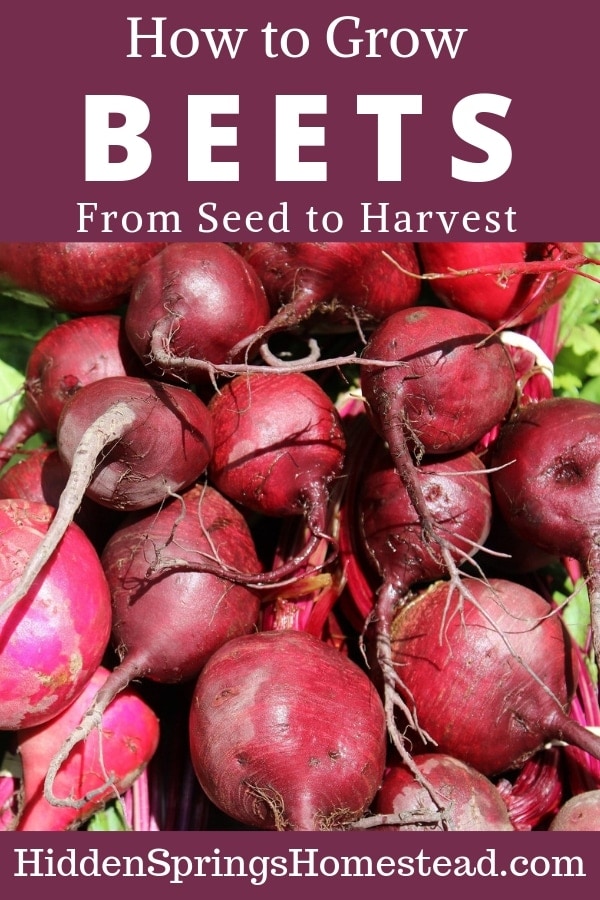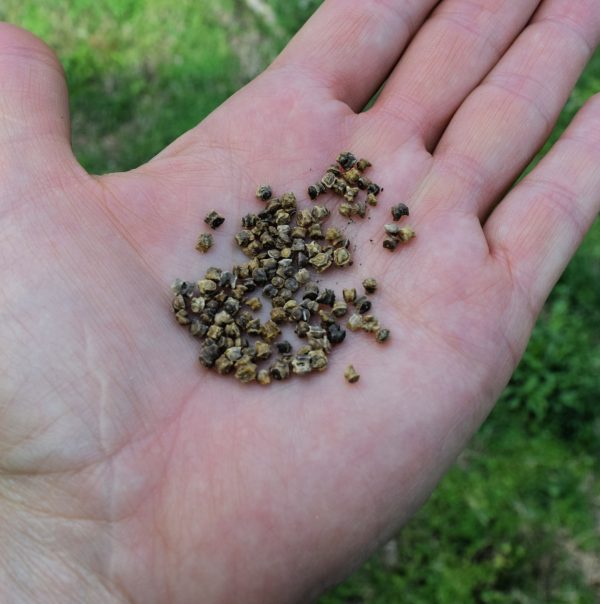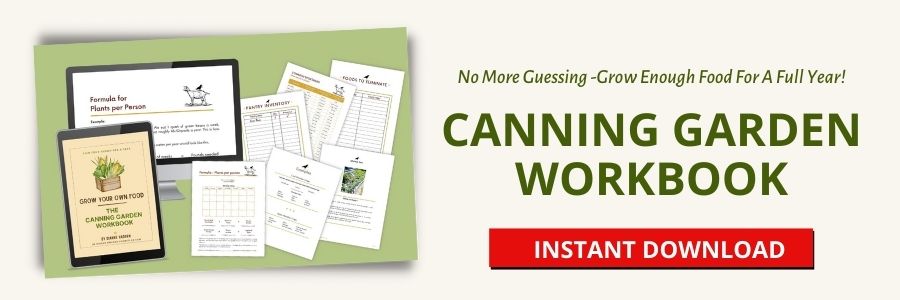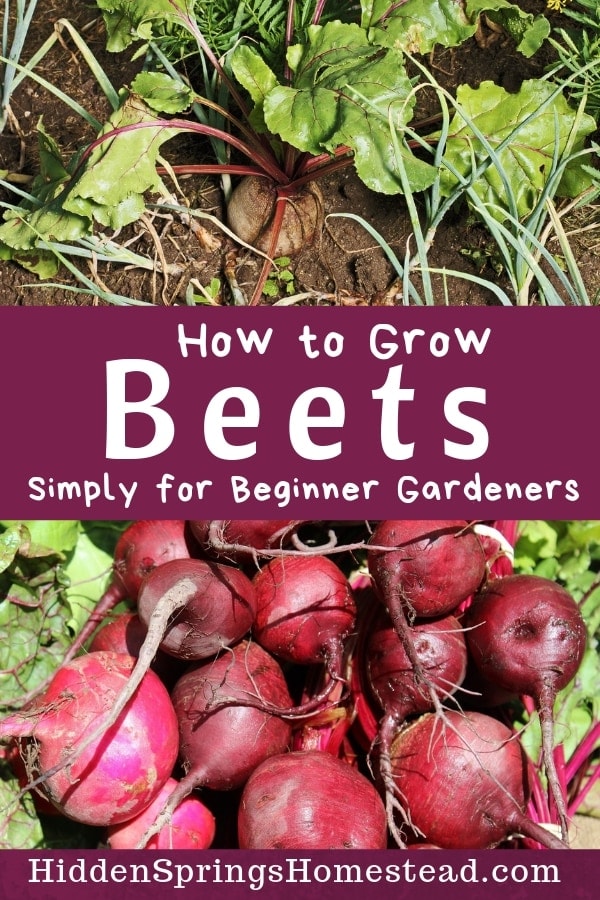Hidden Springs Homestead may earn a commission for purchases made after clicking links on this page. Learn More.
Did you know when you grow beets, you get a bonus? Not only is the beetroot edible, but the green beet tops are also delicious too. Growing beets from seed to harvest – everything you need to know.
Beets are a cool season crop that is easy to grow and so worth the effort to learn how. In many planting zones, beets can be grown in both spring and fall.
A really great thing about growing beets is they will tolerate hard clay. But if grown in high organic soil, they tend not to be as hard and crusty.
RELATED: Even if you’ve never gardened before, this Vegetable Gardening for Beginners Ultimate Guide is for you! Learn everything you need to know from over 60 resources, all in one place, to be a successful gardener, including improving soil, cover crops, warm and cool season crops, organic amendments, fertilizing, watering, and so much more.
How To Grow Beets From Seed to Harvest
How to Grow Beets From Seed
Unlike cucumbers, tomatoes, and many other vegetables that should be started indoors, beets grow best when direct sown in garden soil. They do not transplant well, so starting them inside is not recommended.
- To extend the harvest, beets can be planted in a succession of 2-4 weeks in both the spring and fall garden seasons.
- Succession planting or successive planting means to stagger plantings of a specific crop or plant to prolong or extend harvest maturing dates.
- Beets are fully matured in 6-8 weeks which makes them great for succession planting.
- They don’t require any special treatment, and very few garden pests bother them.
So growing beets is easy to do and perfect for a new gardener or the seasoned gardener too.

When to Start Beets
Since beets grow best in cooler temperatures, seeds can be planted outdoors 3 – 5 weeks prior to the last frost date. Once soil temperatures reach 50°F and can be worked, beets can be sown outdoors.

Beet seeds are little hard clusters that contain 4-6 actual tiny seeds. It is a good idea to soak the seeds overnight before planting. Why should beet seeds be soaked overnight? This will help to soften them up and speed germination.
How to Plant Beet Seeds Into Garden Soil
Beets will germinate in 5-6 days at 60-75°F as long as the soil is kept consistently moist. The best soil for growing beets should also be well-drained and crumbles easily.
Since the seed shells are so hard, even though you soaked them overnight, it is still a good idea to keep the soil consistently moist during germination.
Seeds should be sown 1/2 deep.
They should be planted 2-3 inches apart to provide enough room for the root to have adequate growth space. This will also place them close enough together to allow the leaves to keep the roots shaded, which helps with moisture.
To make the most of the space you have, before you begin, create a garden map to maximize your space – succession planting, rotation, spacing, and more!
Once beet plants reach 2-3 inches in height, thin plants to about 3 inches apart.
BONUS! These can be eaten immediately! They are great for adding to salads and soups. Perfect – no waste!!
Beets also do best when planted in rows about 2 feet apart. Of course, many do square-foot gardening, so you should be able to grow approximately 9 beets in each square.
RELATED: Take the guesswork out! Use the easy formula worksheets in The Canning Garden Workbook (printable) to figure out how much to plant, for canning, to feed your family for a full year!
How Long Do Beets Take To Grow From Seed?
Once the seeds germinate, they grow really fast. They can completely mature in as little as 45-60 days, which is why they are great for succession planting.
Some varieties may take just a few more days to mature. The seed packet you purchased them in will tell you specifically how many days it takes for your particular variety.

Growing TIP: If you prefer a lighter, smoother flavor beet, most beet varieties are perfect for harvesting when they are 1-3 inches in diameter. Larger beets are tougher and have a more fibrous texture.
How to Water Beets
Beets require a moderate amount of water. And it should be applied slowly and evenly to allow it to penetrate deep into the soil.
A great way to water beets is to use a soaker hose or irrigation system. Both of these will water slowly to allow water to soak deep into the soil for the roots to absorb.
On average, beets need 1 inch of water a week. Hotter temperatures will require more water. Mulching will help to hold in moisture.
Do Growing Beets Need Full Sun?
Beets are grown for both leaves and roots. So they are not like vegetables that need to set fruit such as tomatoes or beans. Beets will grow in some shade. They need at least 5-6 hours of sunlight per day.
The more shade they are in, the longer you may have to wait on your harvest. So by getting more sunlight the quicker they will mature.
How To Fertilize Beets
Do beets like manure? Manure is high in nitrogen. The more nitrogen beets get, the more green leaves they will produce. If you want more of the greens, then manure is a great organic fertilizer.
But using only manure will hinder the growth of the beetroot. Roots require phosphorus and potassium, too, as well as nitrogen, to grow.
I would recommend an even blend of Bone Meal, Blood Meal, and Kelp.
- Blood meal is also organic and is high in nitrogen (N) –feeds leaves
- Kelp is a great organic fertilizer that provides potassium (P) –feeds stems
- Bone Meal is organic as well and is high in phosphorus (K) –feeds roots
Fertilize when you plant the seeds and then again about 6 weeks after they have sprouted through the soil.
How To Harvest Beets
How long do beetroots take to grow? Most varieties can be harvested, as I had mentioned earlier, in about 45-60 days. Of course, they can be harvested earlier.
The larger they get, the more fibrous the texture becomes. My favorite beet variety is the Detroit Red, and I will normally harvest them when they are about 1-2 inches in diameter.
What do beets look like when they are ready to harvest? Beetroots will grow the top portion of the root above ground. This is totally acceptable.
This is a good way to judge how large your beetroot is. Gently get a firm grip on the green top where it attaches to the beetroot. With a gentle tug, pull straight up.
Beets have a rather large tap root and can be a bit difficult to pull from the soil. Just keep wiggling and tugging – it will give in and release from the soil.
Beets greens (the tops) should not get over 6 inches tall. They tend to become hard and bitter over this size.

When I harvest my 1-3 inch beetroots, the tops are normally about 4-5 inches tall and very tasty.
How To Store Beets
Beet Tops:
Remove tops from the root, wrap them in a plastic bag, and store them in the refrigerator for up to about 2 weeks.
Beet Roots:
Beets will store in the refrigerator for about 2 weeks as well. Just wash well, leaving on the tap root.
Don’t remove the tap root until you are ready to cook them. Also, leave at least 1 inch of the stem attached to avoid bleeding when cooking.
Long-term storage takes a bit more effort. When you harvest the beetroot, lay them out in the sun to allow the soil to dry well on them.
Then once dry, store in a HUMID basement or cellar for up to 3-4 months. Again, don’t remove the tap root and leave 1 inch of green stem, or your beet will shrivel.
Beets should not be left in the ground over winter. This is because they would continue to grow and become really hard and fibrous. The taste would also become bitter.

Varieties Of Beets
- Early Wonder Tall Top (50 days) Used for early spring sowing. Tops are great for salads and cooking; Roots are great for pickling or sliced for cooking.
I grew Early Wonder for a couple of seasons. I did love the flavor, but when I canned this beet variety, it lost a lot of its deep red color. The taste is wonderful, but I just prefer a deep red beet.
- Detroit Dark Red (60 days) Very popular deep red beet. A super dark green leaf with some red coloration. These can be cooked fresh or canned as well.
- Boro (51 Days) Smooth dark red beet with thick leaves. Great for pickling or roasting
- Chioggia (65 Days) This beet variety has a deep red-colored tap root. They are a lighter red color with white interior rings. Alternating bright pink and white stripes inside. They make a really pretty side dish.
- Mini Ball (50-60 Days) Grows perfectly round. Sweet, tender, petite-sized beets. Perfect for containers.
What Can You Plant With Beets?
The best companions for beets are bush beans, cabbage, corn, leeks, Lima beans, onions, and radishes.
Avoid planting with mustard greens and pole beans
Natural Pest Repellents For Growing Beets
The best natural pest-repellent plants for beets are catnip or mint. Both of these will help to reduce beetle damage.
So, you can see that growing beets is not difficult to do. Do you feel like you can now grow beets? Or maybe you already grow beets but learned something new. Feel free to share with me; I’d love to know.

More Gardening Tips To Know:

Connect with Hidden Springs Homestead!
Be sure to follow me on social media so you never miss a post!

Dianne Hadorn is the owner of Hidden Springs Homestead nestled in the hills of East Tennessee. She is a Master Gardener and enjoys helping others learn how to grow and preserve their own food and sharing tips for living a more self-sufficient lifestyle.

I read your entire article about everything I need to know to grow beets and did not find the ONE THING I NEED TO KNOW. How to keep the moles from eating 90% of my beet crop! Last fall I saw how huge the Detroit red beets had gotten by looking down on them. (I don’t want tiny beets.) I pull up a beet and find the top and the taproot connected by the thinnest membrane of skin…the whole body of the beet gouged out and eaten by some mole. Beet after beet after beet, same thing. I scrounged all the uneaten parts out of sheer anger, cut every edible smidgen from the carcasses, and got a mere 2 quarts of pickled beets out of them. AFTER ALL THAT WORK planting, growing, watering them. So why doesn’t anybody warn us that moles will attack the harvest from underground?
Hi B.Ann,
I hear your frustration and I’m so sorry this happened to you. I agree gardening is hard work when things like this happen, it is so discouraging, but I love the way you pushed forward to get what you could from the culls.
We have voles at times on our farm, thankfully our help to keep them in check. We will see them sitting out it the garden and we know what they are doing. They will then often bring us a dead one as a gift.
I don’t have an article to help you with this, but I did look up and find this one from Bonnie Plants. I’ve read it and kudos’s to them for being thorough. Take a look at this and I hope it helps. At least you’ll know the signs and a couple things you can do to help keep it from happening again. Don’t give up! All the work is so worth it!!
Happy Gardening,
Dianne
Well, this totally explains why I didn’t get a single beet last year. Threw the dried up seeds in the ground, watered casually every day…and nothing. I will definitely soak the seeds and put a soaker hose out this year.
Nice article on growing beets. Lot of good information. I grow beets to sell, and the Boro seem to do very well. The past several years the golden beets have been a good seller. Folks have found they either love them or hate them, no middle road. The golden beets are usually served roasted. This is not a big operation I have going, generally sell less than 300 lbs. per year .
Live in the inland NW part of the country. Rainfall here is eight inches or less per year. Irrigation is a must, used drip irrigation, to save on water.
Usually can plant here till about mid May, then 100 degree days arrive. Then replant in mid August for fall harvest.
For the most part composted cow manure and my homemade compost covers the fertilizer needs of all my garden. I use pelted seed in a Hoss seeder, to plant a double fifty foot row probably takes less than five minutes. The big thing it is much easier on my 80 year old body.
Keep providing the great and necessary information out there on gardening. There are a lot of new gardeners out in today’s world.
I use worm tea for fertilizer how often should I fertilize.
Hi Timothy,
This is a very good question, but it triggers me asking you a question. Let me explain… Both beet roots and beet leaves are edible. So the fertilizer you use will depend on what you are trying to grow. Either larger leaves or larger roots.
The worm tea is an organic nitrogen. So it will feed the leaves but not be much help to the root. But leaves are necessary for absorption of the sun to create carbs to feed the roots. (too much science – sorry, but I want to make to answer your question completely)
To feed the beet root, you will need to use potassium. This can be made by soaking banana peels in water for about 2 weeks. And then watering the beets with it. Or a couple good products to buy that might be a bit easier are kelp meal, seabird guano or potash is an option too. (affiliate links btw) And follow the instructions on the packaging. All 3 of these are good products.
As far as how often to feed them – I would recommend feeding them every 3-4 weeks since they are such heavy feeders.
Happy Gardening,
Dianne